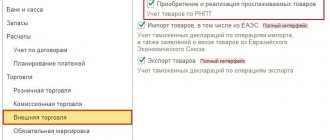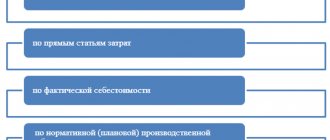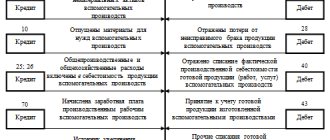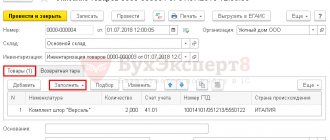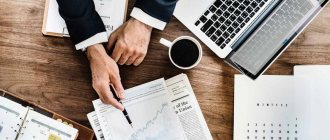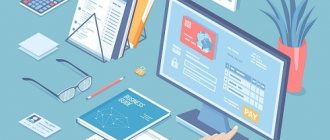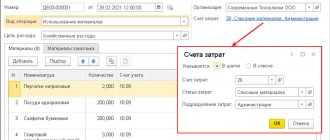Features of inventory accounting
Materials (materials and materials) can be delivered to the enterprise's warehouse by purchase, gratuitous transfer, in the form of a contribution to the authorized capital, or in another way. To account for purchased materials, account 10 “Materials” is used.
The cost of inventories upon receipt at the warehouse can be taken into account as follows:
- at actual cost on account 10;
- at discounted prices. To form the cost of inventories, an additional 15th account is applied.
The selected option for accounting for inventories must be specified in the accounting policy.
Purchase of materials and equipment at a price lower than the discounted price
Kolokolchik LLC purchased from the supplier Arena LLC a batch of material in the amount of 2,000 pieces, the cost of the batch was 480,000 rubles, including VAT 73,220 rubles. The book value of this item is 250 rubles per piece. From this batch, 700 pieces were sent into production.
| Dt | CT | Operation description | Sum | Document |
| 15 | 60 | Reflection of receipt of inventories at actual cost (480000-73220) | 406780 | Invoice |
| 19 | 60 | Incoming VAT (480000*18%) | 73220 | Invoice |
| 60 | Transfer of payment to the supplier | 480000 | Payment order ref. | |
| 10 | 15 | Capitalization of material at accounting prices (2000*250) | 500000 | |
| 15 | 16 | The cost deviation was written off (the excess of the book value over the actual value, 500,000 - 406,780) | 93220 | Accounting information |
| 20 | 10 | Write-off for production (250*700) | 175000 | Request-invoice |
If inventories are actually purchased at a cost lower than the book value, the deviation is reflected by posting Dt 15 - Kt 16.
Account 15 in accounting
The main aspect of using account 15 is that this account summarizes information on the procurement and acquisition of inventories, which relate to funds in circulation:
The difference between the actual cost and the accounting price is called a deviation. To reflect deviations in accounting, account 16 “Deviation in the cost of material assets” is used.
Typical transactions for account 15 are presented in the table below:
| Dt | CT | Contents of operation |
| 60 | 51 (50) | The paid cost of the supplier's inventory is taken into account |
| 15 | 60 | The cost (excluding VAT) of inventories according to the supplier’s accompanying documents is taken into account |
| 19 | 60 | VAT paid included |
| 10 | 15 | The purchased goods and materials were credited to the warehouse at the discount price |
| 15 | 16 | The excess of the book price over the actual cost is written off |
| 16 | 15 | The excess of the actual price over the accounting cost is written off |
Accounting Features
Account 15 is always used in conjunction with special account 16 “Deviation in the cost of material assets.” Thus, the first one reflects information about the costs of procurement, acquisition and delivery of goods and materials, the second one reflects arithmetic calculations of deviations.
In other words, if the cost price is set to be greater than the actual cost, then the difference, calculated arithmetically, is written off to account 16. The accountant makes the following entry:
Dt 15 Kt 16.
In a situation where the actual cost exceeds the CA, the arithmetic balance is written off by reverse posting:
Dt 16 Kt 15.
Postings using accounts 15 and 16 as an example
Example 1
TD "Zima" purchased MPZ in the amount of 2,500 pieces, the total cost of materials was 354,000 rubles, incl. VAT 54,000 rub. Materials were entered into the warehouse at a book price of 160 rubles. for one piece. 500 units were written off for the production of finished products.
Accounting entries using account 15 for inventory accounting:
| Dt | CT | Amount, rub. | Contents of operation | Document |
| 60 | 51 | 354 000 | Reflects payment to supplier for materials | Bank statement |
| 15 | 60 | 300 000 | Purchased materials are taken into account at actual cost, excluding VAT | Consignment note (TORG 12) |
| 19 | 60 | 54 000 | The amount of VAT on purchased materials is taken into account | Invoice received |
| 10 | 15 | 400 000 | Purchased materials are posted to the warehouse at the discount price | Invoice |
| 15 | 16 | 100 000 | The write-off of the excess of the book price over the actual cost is reflected. | Accounting information |
| 20 | 10 | 80 000 | Materials written off for production are taken into account (500 * 160) | Invoice for transfer of materials to production |
| 20 | 16 | 20 000 | At the end of the month we write off the amount of 20,000 rubles. ((0 + 100,000) * 80,000 / (0 + 400,000)) | Accounting information |
Account 15 – postings
Let's say a company purchased a batch of materials of 1000 pieces. total amount of 153,400 rubles, including VAT 18% 130,000 rubles. (at a cost of 130 rubles per piece). In this case, the accounting price is set at 150 rubles. a piece. 750 pieces from this batch were used in production. What records should the company accountant record transactions with? Postings:
- D 15 K 60 for 130,000 rubles. – the receipt of 1000 pieces is reflected. at actual price.
- D 19 K 60 for 23,400 rubles. – VAT allocated for this supply.
- D 60 K 51 for 153,400 rubles. – settlement with the supplier has been made.
- D 10 K 15 for 150,000 rubles. – inventories are accepted for accounting at the established accounting price.
- D 15 K 16 for 20,000 rubles. – the write-off of the excess of the book price over the actual price (150,000 – 130,000) is reflected.
- D 20 K 10 for 112,500 rubles. – the write-off of inventories into production is reflected (750 pcs. x 150 rubles).
If, upon acquisition, the purchase price turns out to be higher than the book price, when writing off the deviation, a reverse entry is made D 16 K 15 for the amount of the difference.
Standard postings to accounts 15 and 16 are made excluding VAT. When the additional acquisition of materials and materials is accompanied by associated transportation and procurement costs, such amounts are also charged to account 15 and are included in the calculation of the actual cost and deviations. You can find more complete information on the topic in ConsultantPlus. Free trial access to the system for 2 days.
Features of accounting for materials using accounts 15 and 16
According to the Instructions for using the Chart of Accounts, the actual cost of materials can be formed in two ways. Option 1 – using only 10 counts, Option 2 – using counts 15 and 16.
Option 1. The cost of materials, as well as the costs of their acquisition, are reflected in the debit of account 10.
Example. Polyus LLC purchases materials for use in production activities. Their cost, determined by the terms of the contract, is 354,000 rubles. (including VAT - 54,000 rubles). The transfer of ownership of the purchased materials occurred on March 15 (i.e., signing of documents - purchase), payment was made on March 16. Payment documents from the supplier were received on March 30. The materials were delivered to the enterprise and entered into the warehouse on April 2. In addition, Polyus LLC incurred the following expenses related to the purchase of materials.
Produced in March:
- travel expenses of a representative of the organization who traveled to the manufacturing plant and accepted materials - 7,400 rubles.
— costs of insuring materials in transit — 7,080 rubles.
In April:
— the transport organization provided services for the delivery of materials, the cost of which amounted to 11,800 rubles. (including VAT - 1,800 rubles).
The following entries will be made in the accounting records of Polyus LLC:
March
D 10 K 60 – 300,000 rub. materials received
D 19 K 60 – 54,000 rub. VAT reflected
D 60 K 19 – 54,000 rub. VAT on purchased materials is deductible
D 10 K 71 – 7400 rub. travel expenses are included in the actual cost of materials.
D 19 K 71 – 360 rub. VAT charged on travel expenses
D 60 K 51 – 354,000 rub. materials paid for
D 10 K 76 – 7080 rub. insurance costs reflected
D 10 K 66 – 1397 rub. interest accrued on the loan
D 91 K 66 – 2792 interest was accrued on the loan after the materials were accepted for accounting (354,000 * 18% / 365 * 16 days).
D 66 K 51 – 4190 (1397+2793) interest paid on the loan
D 66 K 51 354000 reflects the loan repayment.
April
Thus, the actual cost of purchased materials is:
(300,000 + 7,400 + 7,080 + 1,397 + 10,000) = 325,877 rubles.
When organizing materials accounting using account 10, accountants face the following problems. Firstly, the data for the formation of the actual cost of materials may not arrive at the accounting department simultaneously, but with a gap in time. For example, transportation company invoices may lag behind the date of receipt of materials, and then transportation costs are not included in the actual cost at the time of receipt of materials. This also applies to the accounts of intermediary organizations through which materials were purchased.
Secondly, the enterprise’s expenses for maintaining employees working in the warehouse must be included in the actual cost of procured materials in accordance with the principles reflected in the enterprise’s accounting policies. Moreover, such expenses are usually distributed at the end of the reporting month.
Thirdly, the material can be written off for production even before its actual cost is finalized.
Thus, the method of forming the actual cost of procuring materials using account 10 “Materials” is advisable to use for enterprises that have a small number of supplies of materials with a small range of materials; All data for the formation of the actual cost of materials, as a rule, is received by the accounting department in a timely manner.
Option 2 - creating the cost of materials using accounts 15 and 16
This accounting method is convenient when an enterprise uses a variety of materials in its activities, the prices of which change, with constant changes in the cost of transport services and other expenses included in the cost. In this case, materials can be accounted for at accounting (planned) prices, which are calculated and remain fixed for some time. With this accounting method, accounts 15 and 16 are used.
According to the Instructions for using the Chart of Accounts, if an organization uses accounts 15 and 16, on the basis of supplier settlement documents received by the organization, an entry is made to debit account 15 and credit accounts 60, 20, 23, 71, 76, etc. depending on where certain values came from, and on the nature of the costs of procuring and delivering materials to the organization. In this case, the entry to the debit of account 15 and the credit of account 60 is made regardless of when the materials arrived at the organization - before or after receiving the supplier’s payment documents.
The posting of materials actually received by the organization is reflected by an entry in the debit of account 10 and the credit of account 15.
The amount of the difference in the cost of acquired inventories, calculated in the actual cost of acquisition (procurement), and accounting prices is written off from account 15 to account 16.
Account balance 15 at the end of the month shows the availability of inventories on the way.
Thus, all costs that form the actual cost of materials are reflected in the debit of account 15. When materials are received by the enterprise, they are charged to account 10 at accounting prices. The difference between the actual cost of materials and their cost in accounting prices is reflected in the correspondence of accounts 15 and 16.
Enterprises are given the right to independently establish the principles for forming the accounting price. Any chosen method for forming the accounting price of materials must be enshrined in the accounting policy of the enterprise. The accounting price (at the choice of the enterprise) can be taken, for example, any of the following:
— supplier price;
— actual cost of materials according to the previous month;
— fixed price approved for a certain period of time;
— planned accounting price;
— average price of the group.
The specified operations are documented by postings:
Debit 15 Credit 60, 71, 76 - reflects the purchase price of materials and other expenses associated with their acquisition.
Debit 10 Credit 15 - materials are capitalized at accounting prices.
Debit 15 Credit 16 - the excess of the book price over the actual cost is written off.
Debit 16 Credit 15 - the excess of the actual cost over the book price is written off.
Materials in production cost accounts are written off at accounting prices, so at the end of the month you need to adjust and bring the cost of written-off materials to the actual cost.
If accounting prices are less than the actual cost, positive differences between the actual cost of materials and accounting prices (debit balance) accumulate on account 16. These differences are written off to the debit of cost accounting accounts: Debit 20, 23, 25, 26 Credit 16.
If accounting prices exceed the actual cost, then negative differences between the actual cost of materials and accounting prices (credit balance) accumulate on account 16. These amounts are reversed: Debit 20, 23, 25, 26: Credit 16 Reversal.
Deviations accumulated on account 16 are written off in groups in proportion to the cost of materials released into production at accounting prices. To do this, you need to determine the percentage of the cost of materials written off for production in the total cost of materials (the sum of the balance at the beginning of the month and the cost of received materials). The amount of deviations to be written off is determined by multiplying the resulting value by the total amount of deviations (balance at the beginning plus receipt).
Example. Let's use the conditions of example 2, in which we determined that the actual cost of purchased materials was 325,877 rubles. During the month, materials worth RUB 410,000 were written off for production. in planned accounting prices.
At the beginning of the month, the balance of materials on account 10 at planned accounting prices is 270,000 rubles; debit balance on account 16 - 10,800 rubles.
Option 1.
The accounting price of purchased materials is RUB 300,000. (below the actual cost).
Share of the cost of materials released into production in the total cost of materials: 410,000 rubles. / (270,000 + 300,000) rub. x 100 = 72%.
Amount of deviations in the cost of materials to be written off: (10,800 + 25,877) rub. x 72% = 26,407 rub.
┌───────────────────────────────────────────────────┬───────────────┬──────────────┬───────────────┐
│ Contents of the transaction │ Debit │ Credit │ Amount, rub. │
├───────────────────────────────────────────────────┼───────────────┼──────────────┼───────────────┤
│The actual cost of the purchase was generated -│ 15 │ 60, 66, │ 325,877 │
│ materials │ │ 71, 76 │ │
├───────────────────────────────────────────────────┼───────────────┼──────────────┼───────────────┤
│Materials were capitalized at accounting prices │ 10 │ 15 │ 300,000 │
├───────────────────────────────────────────────────┼───────────────┼──────────────┼───────────────┤
│Excess of actual cost written off│ 16 │ 15 │ 25,877 │
│materials above the discount price │ │ │ │
├───────────────────────────────────────────────────┼───────────────┼──────────────┼───────────────┤
│Materials written off for production │ 20 │ 10 │ 410,000 │
├───────────────────────────────────────────────────┼───────────────┼──────────────┼───────────────┤
│The deviation in the cost of materials was written off │ 20 │ 16 │ 26,407 │
└───────────────────────────────────────────────────┴───────────────┴──────────────┴───────────────┘
Balance of account 10 “Materials” at the end of the month in accounting prices: (270,000 + 300,000 - 410,000) rub. = 160,000 rub.
Balance on account 16 at the end of the month (by debit): (10,800 + 25,877 - 26,407) rub. = 10,270 rub.
Option 2.
The accounting price of purchased materials is RUB 350,000. (higher than actual cost).
Share of the cost of materials released into production in the total cost of materials: 410,000 rubles. / (270,000 + 350,000) rub. x 100 = 66%.
Amount of deviations in the cost of materials to be written off: (10,800 - 24,123) rub. x 66% = - 8,793 rub.
┌─────────────────────────────────────────────────────┬──────────────┬─────────────┬───────────────┐
│ Contents of the transaction │ Debit │ Credit │ Amount, rub. │
├─────────────────────────────────────────────────────┼──────────────┼─────────────┼───────────────┤
│The actual cost of purchased items was generated│ 15 │ 60, 66, │ 325 877 │
│materials │ │ 71, 76 │ │
├─────────────────────────────────────────────────────┼──────────────┼─────────────┼───────────────┤
│Materials were capitalized at accounting prices │ 10 │ 15 │ 350,000 │
├─────────────────────────────────────────────────────┼──────────────┼─────────────┼───────────────┤
│Excess of actual cost written off│ 15 │ 16 │ 24 123 │
│materials above the discount price │ │ │ │
├─────────────────────────────────────────────────────┼──────────────┼─────────────┼───────────────┤
│Materials written off for production │ 20 │ 10 │ 410,000 │
├─────────────────────────────────────────────────────┼──────────────┼─────────────┼───────────────┤
│Reversal │ 20 │ 16 │ (8,793) │
│The deviation in the cost of materials has been written off │ │ │ │
└─────────────────────────────────────────────────────┴──────────────┴─────────────┴───────────────┘
Account balance 10 at the end of the month in accounting prices: (270,000 + 350,000 - 410,000) rub. = 210,000 rub.
Balance on account 16 at the end of the month (on loan): ((24,123 - 8,793) rubles - 10,800 rubles) = 4,530 rubles.
In conclusion, I would like to note: if materials are accounted for at planned accounting prices using accounts 15 and 16, then when reflecting the balances of materials in the balance sheet, the debit balance of account 16 is added to the value of the balances of inventories reflected in the corresponding items of the group of items “Inventories” . If the balance on account 16 is credit, then the corresponding amount is deducted from the value of the balances of the inventory. Thus, the balance sheet reflects the actual cost of inventory balances, regardless of whether they are accounted for at actual cost or at planned accounting prices.
According to the Instructions for using the Chart of Accounts, the actual cost of materials can be formed in two ways. Option 1 – using only 10 counts, Option 2 – using counts 15 and 16.
Option 1. The cost of materials, as well as the costs of their acquisition, are reflected in the debit of account 10.
Example. Polyus LLC purchases materials for use in production activities. Their cost, determined by the terms of the contract, is 354,000 rubles. (including VAT - 54,000 rubles). The transfer of ownership of the purchased materials occurred on March 15 (i.e., signing of documents - purchase), payment was made on March 16. Payment documents from the supplier were received on March 30. The materials were delivered to the enterprise and entered into the warehouse on April 2. In addition, Polyus LLC incurred the following expenses related to the purchase of materials.
Produced in March:
- travel expenses of a representative of the organization who traveled to the manufacturing plant and accepted materials - 7,400 rubles.
— costs of insuring materials in transit — 7,080 rubles.
In April:
— the transport organization provided services for the delivery of materials, the cost of which amounted to 11,800 rubles. (including VAT - 1,800 rubles).
The following entries will be made in the accounting records of Polyus LLC:
March
D 10 K 60 – 300,000 rub. materials received
D 19 K 60 – 54,000 rub. VAT reflected
D 60 K 19 – 54,000 rub. VAT on purchased materials is deductible
D 10 K 71 – 7400 rub. travel expenses are included in the actual cost of materials.
D 19 K 71 – 360 rub. VAT charged on travel expenses
D 60 K 51 – 354,000 rub. materials paid for
D 10 K 76 – 7080 rub. insurance costs reflected
D 10 K 66 – 1397 rub. interest accrued on the loan
D 91 K 66 – 2792 interest was accrued on the loan after the materials were accepted for accounting (354,000 * 18% / 365 * 16 days).
D 66 K 51 – 4190 (1397+2793) interest paid on the loan
D 66 K 51 354000 reflects the loan repayment.
April
Thus, the actual cost of purchased materials is:
(300,000 + 7,400 + 7,080 + 1,397 + 10,000) = 325,877 rubles.
When organizing materials accounting using account 10, accountants face the following problems. Firstly, the data for the formation of the actual cost of materials may not arrive at the accounting department simultaneously, but with a gap in time. For example, transportation company invoices may lag behind the date of receipt of materials, and then transportation costs are not included in the actual cost at the time of receipt of materials. This also applies to the accounts of intermediary organizations through which materials were purchased.
Secondly, the enterprise’s expenses for maintaining employees working in the warehouse must be included in the actual cost of procured materials in accordance with the principles reflected in the enterprise’s accounting policies. Moreover, such expenses are usually distributed at the end of the reporting month.
Thirdly, the material can be written off for production even before its actual cost is finalized.
Thus, the method of forming the actual cost of procuring materials using account 10 “Materials” is advisable to use for enterprises that have a small number of supplies of materials with a small range of materials; All data for the formation of the actual cost of materials, as a rule, is received by the accounting department in a timely manner.
Option 2 - creating the cost of materials using accounts 15 and 16
This accounting method is convenient when an enterprise uses a variety of materials in its activities, the prices of which change, with constant changes in the cost of transport services and other expenses included in the cost. In this case, materials can be accounted for at accounting (planned) prices, which are calculated and remain fixed for some time. With this accounting method, accounts 15 and 16 are used.
According to the Instructions for using the Chart of Accounts, if an organization uses accounts 15 and 16, on the basis of supplier settlement documents received by the organization, an entry is made to debit account 15 and credit accounts 60, 20, 23, 71, 76, etc. depending on where certain values came from, and on the nature of the costs of procuring and delivering materials to the organization. In this case, the entry to the debit of account 15 and the credit of account 60 is made regardless of when the materials arrived at the organization - before or after receiving the supplier’s payment documents.
The posting of materials actually received by the organization is reflected by an entry in the debit of account 10 and the credit of account 15.
The amount of the difference in the cost of acquired inventories, calculated in the actual cost of acquisition (procurement), and accounting prices is written off from account 15 to account 16.
Account balance 15 at the end of the month shows the availability of inventories on the way.
Thus, all costs that form the actual cost of materials are reflected in the debit of account 15. When materials are received by the enterprise, they are charged to account 10 at accounting prices. The difference between the actual cost of materials and their cost in accounting prices is reflected in the correspondence of accounts 15 and 16.
Enterprises are given the right to independently establish the principles for forming the accounting price. Any chosen method for forming the accounting price of materials must be enshrined in the accounting policy of the enterprise. The accounting price (at the choice of the enterprise) can be taken, for example, any of the following:
— supplier price;
— actual cost of materials according to the previous month;
— fixed price approved for a certain period of time;
— planned accounting price;
— average price of the group.
The specified operations are documented by postings:
Debit 15 Credit 60, 71, 76 - reflects the purchase price of materials and other expenses associated with their acquisition.
Debit 10 Credit 15 - materials are capitalized at accounting prices.
Debit 15 Credit 16 - the excess of the book price over the actual cost is written off.
Debit 16 Credit 15 - the excess of the actual cost over the book price is written off.
Materials in production cost accounts are written off at accounting prices, so at the end of the month you need to adjust and bring the cost of written-off materials to the actual cost.
If accounting prices are less than the actual cost, positive differences between the actual cost of materials and accounting prices (debit balance) accumulate on account 16. These differences are written off to the debit of cost accounting accounts: Debit 20, 23, 25, 26 Credit 16.
If accounting prices exceed the actual cost, then negative differences between the actual cost of materials and accounting prices (credit balance) accumulate on account 16. These amounts are reversed: Debit 20, 23, 25, 26: Credit 16 Reversal.
Deviations accumulated on account 16 are written off in groups in proportion to the cost of materials released into production at accounting prices. To do this, you need to determine the percentage of the cost of materials written off for production in the total cost of materials (the sum of the balance at the beginning of the month and the cost of received materials). The amount of deviations to be written off is determined by multiplying the resulting value by the total amount of deviations (balance at the beginning plus receipt).
Example. Let's use the conditions of example 2, in which we determined that the actual cost of purchased materials was 325,877 rubles. During the month, materials worth RUB 410,000 were written off for production. in planned accounting prices.
At the beginning of the month, the balance of materials on account 10 at planned accounting prices is 270,000 rubles; debit balance on account 16 - 10,800 rubles.
Option 1.
The accounting price of purchased materials is RUB 300,000. (below the actual cost).
Share of the cost of materials released into production in the total cost of materials: 410,000 rubles. / (270,000 + 300,000) rub. x 100 = 72%.
Amount of deviations in the cost of materials to be written off: (10,800 + 25,877) rub. x 72% = 26,407 rub.
┌───────────────────────────────────────────────────┬───────────────┬──────────────┬───────────────┐
│ Contents of the transaction │ Debit │ Credit │ Amount, rub. │
├───────────────────────────────────────────────────┼───────────────┼──────────────┼───────────────┤
│The actual cost of the purchase was generated -│ 15 │ 60, 66, │ 325,877 │
│ materials │ │ 71, 76 │ │
├───────────────────────────────────────────────────┼───────────────┼──────────────┼───────────────┤
│Materials were capitalized at accounting prices │ 10 │ 15 │ 300,000 │
├───────────────────────────────────────────────────┼───────────────┼──────────────┼───────────────┤
│Excess of actual cost written off│ 16 │ 15 │ 25,877 │
│materials above the discount price │ │ │ │
├───────────────────────────────────────────────────┼───────────────┼──────────────┼───────────────┤
│Materials written off for production │ 20 │ 10 │ 410,000 │
├───────────────────────────────────────────────────┼───────────────┼──────────────┼───────────────┤
│The deviation in the cost of materials was written off │ 20 │ 16 │ 26,407 │
└───────────────────────────────────────────────────┴───────────────┴──────────────┴───────────────┘
Balance of account 10 “Materials” at the end of the month in accounting prices: (270,000 + 300,000 - 410,000) rub. = 160,000 rub.
Balance on account 16 at the end of the month (by debit): (10,800 + 25,877 - 26,407) rub. = 10,270 rub.
Option 2.
The accounting price of purchased materials is RUB 350,000. (higher than actual cost).
Share of the cost of materials released into production in the total cost of materials: 410,000 rubles. / (270,000 + 350,000) rub. x 100 = 66%.
Amount of deviations in the cost of materials to be written off: (10,800 - 24,123) rub. x 66% = - 8,793 rub.
┌─────────────────────────────────────────────────────┬──────────────┬─────────────┬───────────────┐
│ Contents of the transaction │ Debit │ Credit │ Amount, rub. │
├─────────────────────────────────────────────────────┼──────────────┼─────────────┼───────────────┤
│The actual cost of purchased items was generated│ 15 │ 60, 66, │ 325 877 │
│materials │ │ 71, 76 │ │
├─────────────────────────────────────────────────────┼──────────────┼─────────────┼───────────────┤
│Materials were capitalized at accounting prices │ 10 │ 15 │ 350,000 │
├─────────────────────────────────────────────────────┼──────────────┼─────────────┼───────────────┤
│Excess of actual cost written off│ 15 │ 16 │ 24 123 │
│materials above the discount price │ │ │ │
├─────────────────────────────────────────────────────┼──────────────┼─────────────┼───────────────┤
│Materials written off for production │ 20 │ 10 │ 410,000 │
├─────────────────────────────────────────────────────┼──────────────┼─────────────┼───────────────┤
│Reversal │ 20 │ 16 │ (8,793) │
│The deviation in the cost of materials has been written off │ │ │ │
└─────────────────────────────────────────────────────┴──────────────┴─────────────┴───────────────┘
Account balance 10 at the end of the month in accounting prices: (270,000 + 350,000 - 410,000) rub. = 210,000 rub.
Balance on account 16 at the end of the month (on loan): ((24,123 - 8,793) rubles - 10,800 rubles) = 4,530 rubles.
In conclusion, I would like to note: if materials are accounted for at planned accounting prices using accounts 15 and 16, then when reflecting the balances of materials in the balance sheet, the debit balance of account 16 is added to the value of the balances of inventories reflected in the corresponding items of the group of items “Inventories” . If the balance on account 16 is credit, then the corresponding amount is deducted from the value of the balances of the inventory. Thus, the balance sheet reflects the actual cost of inventory balances, regardless of whether they are accounted for at actual cost or at planned accounting prices.
The difference between the accounting price of inventories and their actual cost
The difference (deviation) between the accounting price of inventories and their actual cost is written off to account 16 “Deviation in the cost of material assets.”
If the accounting price exceeds the actual cost, an entry is made in the debit of account 15 and the credit of account 16.
Debit 15 Credit 16 – the excess of the book price of materials over their actual cost is written off (savings).
If the accounting price of inventories is less than their actual cost, the following entry is made:
Debit 16 Credit 15 – the excess of the actual cost of inventories over their book price (overexpenditure) is written off.
Typical entries for accounting for cost deviations of inventory items
Let's look at account correspondence using examples.
Boards were purchased for the construction workshop: 400 linear meters of edged material at a price of 200 rubles per meter, including VAT. The planned price of the MC is 150 rubles per meter, lower than the actual one.
Postings:
- D 10 K15 — 60,000.00 rub. (150*400) – boards were capitalized to the warehouse at discount prices.
- D 15 K60 — 67797.00 rub. – actual cost of received boards.
- D 19 K60 – 12203.00 rub. – VAT. —————————————————————— RUB 80,000.00 (400*200).
- D 16 K15 - 7797.00 rubles (67797-60000) - reflects the excess of the actual price of the boards over the accounting price (overexpenditure).
Let the planned price of boards under the same conditions be 250 rubles per meter, that is, higher than the actual one.
- D 10 K15 – 100,000.00 (250*400) - boards are accepted at discount prices for the warehouse.
- D 15 K60 — 67797.00 rub. – actual cost of received boards.
- D 19 K60 – 12203.00 rub. – VAT. —————————————————————— RUB 80,000.00 (400*200).
- D15 K16 – 32203.00 rubles (100000-67797) - reflects the excess of the accounting price of the boards over the actual one (savings).
At the end of the month, in proportion to the cost of materials, their increase in price is written off to the debit of those accounts to which the materials themselves were written off:
- D 20 (23,29,25,26, etc.) K 16.
- The increase in price of sold MC is written off to account 91/2.
- D 91/2 K 16.
- The increase in the price of goods sold is written off to account 90/2.
- D 90/2 K 16.
If the accounting price exceeds the actual price (a credit balance appears on account 16), deviations are also calculated. Reversal entries are made similar to those given above. Amounts are most often written off in proportion to the cost of materials.
How to use account 15 if discount prices are not applied ?
Example
Let it be at 1.01. of the current month on account 16 there is a loan balance of 3800 rubles, a debit turnover of 5700.00 rubles, and a credit turnover of 1100.00 rubles. At the end of the month, a debit balance is formed in the amount of 800 rubles, subject to distribution. On account 10, the balance as of January 1 of the current month is 2000.00 rubles, receipt of materials in the amount of 78,000.00 rubles, write-off to production - 40,000.00 rubles. Posting - D 20 K10 - 40,000.00 rubles - materials are written off for production at discount prices.
We will calculate the amount of deviations to be written off. Cost of materials 2000+78000 = 80000.00 rubles. 800/80000= 0.01. 0.01 *40000= 400 rubles. Wiring - D 20 K 16 - 400.00 rubles.
Analytics for account 16 is organized by inventory groups with a similar level of deviations of accounting prices from actual indicators. It is advisable to combine it with a grouping of materials of the same type in purpose and use in the production process.
Instructions 15 count
Instructions for using the chart of accounts for accounting the financial and economic activities of organizations in accordance with Order No. 94n dated October 31, 2000:
Account 15 “Procurement and acquisition of material assets” is intended to summarize information on the procurement and acquisition of inventories related to funds in circulation.
The debit of account 15 “Procurement and acquisition of material assets” includes the purchase value of inventories for which the organization received payment documents from suppliers. In this case, entries are made in correspondence with accounts 60 “Settlements with suppliers and contractors”, 20 “Main production”, 23 “Auxiliary production”, 71 “Settlements with accountable persons”, 76 “Settlements with various debtors and creditors”, etc. . depending on where certain values came from, and on the nature of the costs of procuring and delivering inventories to the organization.
The credit of account 15 “Procurement and acquisition of material assets” in correspondence with account 10 “Materials” includes the cost of inventories actually received by the organization and recorded.
The amount of the difference in the cost of acquired inventories, calculated in the actual cost of acquisition (procurement), and accounting prices is written off from account 15 “Procurement and acquisition of material assets” to account 16 “Deviation in the cost of material assets.”
The balance of account 15 “Procurement and acquisition of material assets” at the end of the month shows the availability of inventories on the way.

